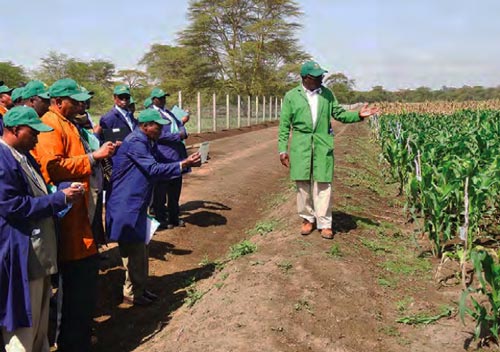“If I have not touched ugali, I have not eaten,” said engineer Menjo Mosonik, the Bomet County official in charge of agriculture and infrastructure. The saying is from his community where ugali, a dish made from maize meal, is a staple food. This is true of many communities in Kenya, where maize is a staple food and a key ingredient in daily meals.
The maize lethal necrosis (MLN) disease, which can cause up to 100 percent yield loss on farmers’ fields, is threatening this source of food and livelihoods for many in the country. Because of this, 40 county officials, including County Executive Committee (CEC) officials who are responsible for agriculture in Kenya’s devolved government structure, visited the CIMMYT MLN Screening Facility in Naivasha, Kenya on 5 August.
The facility could hold the key to addressing this lethal disease, which was first recognized in 2011 and has affected maize cultivation in many counties. The facility is hosted by the Kenya Agricultural Research Institute (KARI) center for livestock research, which is also the Regional Centre of Excellence for Dairy Research for East and Central Africa.
“We work in partnership,” said CIMMYT’s regional representative for Africa, Dr. Wilfred Mwangi, as he welcomed the CECs. “To show our commitment to overcoming MLN, CIMMYT brought our specialists from China and Mexico to help identify the disease when it was first observed in Kenya.”

The Food and Agriculture Organization of the United Nations (FAO) organized the visit and is supporting training sessions on the disease in major maize growing areas. So far, they have trained 320 participants in eight counties. “We wanted policy-makers to appreciate work being done by national and international research organizations to address MLN,” said Dr. Wilson Ronno, head of crop production at FAO-Kenya. “We realized we need to inform policy-makers, as this is a very sensitive issue of food security,” said Ronno, adding, “we are putting up demonstration sites in Bomet to show farmers how to manage the disease through good agricultural practices.”
The county officials were given a guided tour of the facility by Dr. George Mahuku, CIMMYT pathologist. As he showed them around the facility, Mahuku explained the research being carried out by CIMMYT, in collaboration with KARI and partners from the public and private sectors, to screen germplasm and identify sources of resistance to MLN.
“We are screening germplasm from different places in the [East Africa] region,” said Mahuku, adding that germplasm from Mexico and the United States has also been screened at the facility. “Because this is a new disease, we are also developing protocols on how to handle the viruses and screen germplasm for resistance. These protocols will be shared with our partners through training so that we are all well-coordinated in addressing the problem,” he added.
“There is hope,” said Mahuku as he pointed at germplasm that is showing tolerance to the deadly disease. He explained that CIMMYT is going to screen the germplasm in multiple environments. “This is why we really value partnerships,” he added, emphasizing the important role partners play in the research process.
The role of extension workers in managing diseases such as MLN was discussed, as they are instrumental in disseminating information on how to manage the disease. “Management is very important and is going to play a key role in minimizing or averting the devastating effects of MLN,” said Mahuku.
“This was a learning experience. We will be able to tell farmers what we have seen,” said Purity Muritu, who is in charge of agriculture in Nakuru County. Muritu said she would also explain to farmers the importance of having a maize-free season to break the MLN cycle. The CECs suggested that county officials visit the MLN facility to be sensitized on MLN and how to manage it.
 Capacity development
Capacity development 
